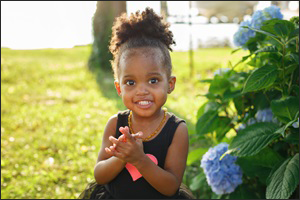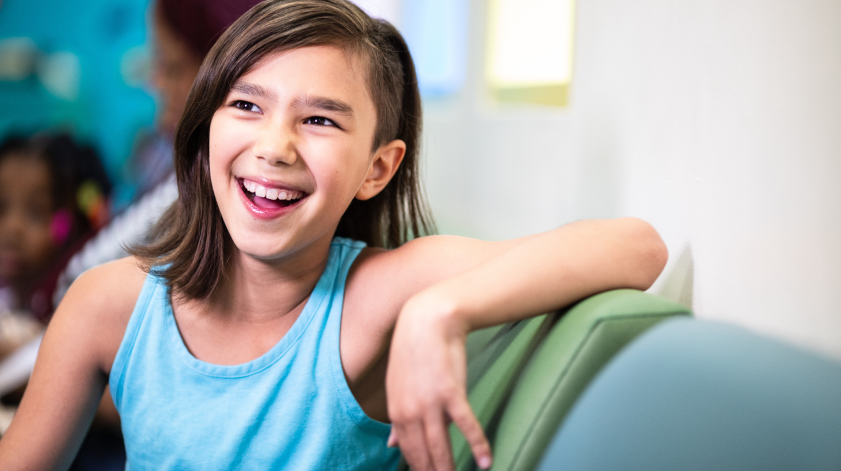
Gabriella's Story

Two-and-a-half-year-old Gabriella “Gabby” Nelson knows her favorite things.
Her favorite foods are flavored with cheese. Sometimes the toddler cuts out the middleman and goes straight for the shredded cheese itself. She likes the baby shark song (doo doo doo doo doo doo). And she’s done her own musical remix: She starts singing her ABCs and, around the letter “g,” she mixes in “Twinkle, Twinkle Little Star.” She knows the Daddy Finger song in Russian; flipping through YouTube during dialysis, the Russian version came on, so that’s what Gabriella learned.
And she’s got her favorite dance, mimicking the smooth moves she saw in a James Brown video, accompanying them with the Godfather of Soul’s lyrics, “Baby, baby, baby.” But Gabriella’s absolute favorite thing is her brand-new kidney.
“Where is your kidney?” asks Gabriella’s mom, Angela Clayton.
Gabriella lifts up her shirt and says “Pretty, pretty, kidney.”
Just a few months ago, Gabriella wasn’t her active, lively, vibrant self. The first clue that things were going awry started with her face. Right after Thanksgiving, Gabriella woke with a swollen eye. Over the course of the day, her eye gradually opened. Thinking it was a food allergy, Clayton restricted her daughter’s diet. But when she picked her up from day care, Gabriella’s eye remained swollen. The doctor sent the family to Children’s National as soon as they arrived. Gabriella was diagnosed with nephrotic syndrome, which meant her kidneys were leaking protein.
The kidneys are small organs shaped like kidney beans that play an important role in maintaining overall health. If you place your hands on your hips, each kidney would lie just above your thumbs. Normal kidneys filter blood, thus removing waste products and extra fluid through the urine.
Children’s clinicians thought Gabriella had minimal change disease and prescribed steroids, but she did not respond to the treatment. Gabriella’s ankles remained swollen as she continued to retain fluids. By the end of December 2017, the fluid retention worsened and Gabriella felt lousy. Shortly before New Year’s Day 2018, she underwent a renal biopsy, which revealed she had scars in the kidney’s filtering units, a condition known as focal segmental glomerulosclerosis (FSGS).
Gabriella, then aged 16 months, had been doing typical toddler things: running around, eating a variety of foods, drinking on her own from a sippy cup. With the FSGS diagnosis, Gabriella was restricted to drinking 10 ounces of fluid daily. She was hospitalized for nearly one month, from late December 2017 to late January 2018. With the help of Asha Moudgil, M.D., transplant medical director at Children’s National, Gabriella started dialysis, which takes over for failing kidneys by filtering waste, salt and water from the blood. She also had a catheter inserted into one of her neck veins for the purpose of dialysis. Gabriella’s daily fluid limit dropped to 4 ounces because she stopped urinating. She developed high blood pressure and needs several medications to control it.
“I went back to bottles. She was drinking too fast from the sippy cups. The only way to slow her down was using the bottle,” her mom recalls. Gabriella could no longer eat fruit or vegetables due to their water content.
“I did a lot of talking to the nutritionist,” she says. “I couldn’t even sneak in vegetables by juicing them. I had to stop making applesauce. She had to have Greek yogurt, which had less water in it. It was a lot of learning and researching.”
Gabriella weighed 14 kilos when she started dialysis at the hospital. Removing excess fluid via dialysis treatment brought her weight down to 7.1 kilos. When Gabriella was in need of transplant, her mom sent information to cousins, aunts and uncles. One cousin replied with a cryptic text: “Get tested tomorrow.” A cousin through marriage, Michelle Harris, has an A-positive blood type like Gabriella and was a willing donor. As Harris got ready to donate a kidney, Gabby’s mom tried to bulk Gabby up, as Gabriella needed to weigh at least 10 kilos to undergo the transplant surgery. Children’s set the surgery date at Oct. 10, 2018, but Gabriella was just shy of 10 kilos.
“The surgeon Jennifer Verbesey, M.D., came in and looked at her stature and took pictures of her stomach and said ‘it looks like we’ll have enough space,’ ” mom recalls.
With her new kidney, Gabriella can now drink 40 ounces of fluid daily and can eat anything, though she loves grits with cheese, shredded cheese, macaroni and cheese, crackers with peanut butter, and any kind of sweet – even though before the transplant she never ate any sugar. Now after transplant, she’s back to her sippy cup and working on regaining her fork and spoon skills and potty training. She is gaining weight, height and body strength.
Her mom says to the transplant team: “You did not warn me that she would get all this energy after transplant, which wears me out.”
The toddler now has a grown adult’s kidney which is located in the front to the right of her belly button. Her two native kidneys that don’t work remain in the back.
Just ask Gabriella. She knows. Every morning she asks her mom to kiss her “pretty, pretty kidney.”



